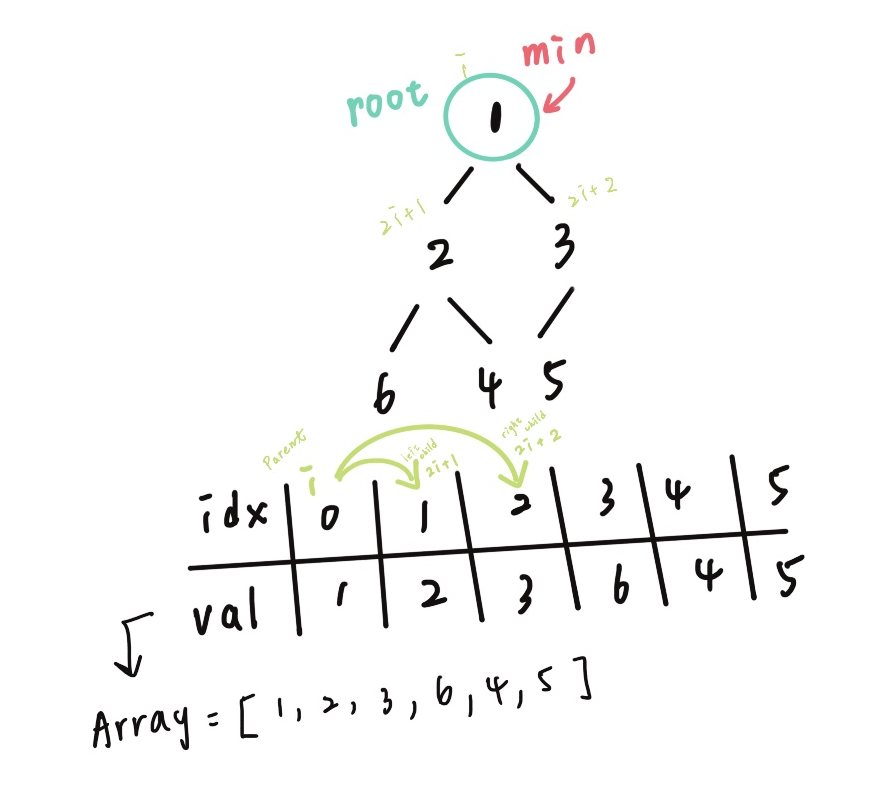在實作之前我們先來認識Heap
堆積 (Heap),是一種特殊的完全(complete)二元樹,也就是除了最後一層樹葉,每一層都是長滿的。
而今天要建構的Min-Heap多了一個特點,就是了父結點都要小於或等於子結點; 相反的,Max-Heap則是父結點都要大於或等於子結點。
我將要用一個沒有被排列過的陣列,採用in-place的方式,來建構出一個符合min-Heap性質的陣列,我們會實作兩個函式,分別是heapifyDown() 和 heapifyUp(),它們都可以用來建構Min-Heap(build Heap),此外我們還需要其他兩個函式分別是insert()以及remove()。
實作兩個函式前我們要先知道如何推得heap的父結點t以及子結點的索引(index)以及它們之間的關係式。我們先以下圖為例

我可以觀察出,假設現在在的節點 index = i
則 leftChild = 2i+1 ; rightChild = 2i+2,而 parent = (i-1) / 2 取 floor
利用這種簡單的計算方式,我們就可以很輕易地取得parent和child(以O(1)的時間複雜度)
接下來我們就來看如何在heap中插入節點→ insert()
假設我們今天要把上方的heap加入0,我們該如何操作?
我們會把0加在最後面(last node),也就是3的rightChild,但我們知道加進去的元素不可能一定洽在正確的位置,所以我們需要將它作向上調整的動作( heapifyUp() ),這個方法會不斷的將插入的節點與其父節點比較,若有需要則會swap()
以這張圖來說:因為 3 > 0 所以需要交換,以次類推如下圖,最後可以獲得最右邊的min heap
若用陣列的幾角度來看 ,則是利用push的方式加到陣列最後面 array = [ 1, 2, 3, 6, 4, 5, 0],0的index為6,要比較的parent就是 floor((6-1)/2) = 2 (array[2] = 3),我們直接在array做swap的動作。以下先來寫swap()
const swap = (i, j, heap) => {
const tmp = heap[j];
heap[j] = heap[i];
heap[i] = tmp;
}
不過在這裡暫停一下,先來寫remove(),這裡的remove我們要做的是:移除heap的最小值(以後一定會碰到我們用heap的資料結構來移除最大或最小值 → peek() 其實就是回傳array[0] )
操作方式如下:
我們直接把array的array[0]和array的最後一個元素(array[array.length-1])做swap,然後直接用pop()的方式移除陣列最後一個元素,而後再對heap做調整(heapifyDown():其實就是拿array[0]開始往後調整的感覺),換作是圖就會如下。
注意heapifyDown是要把左右兒子小的往上面交換
若用陣列的幾角度來看 ,則是先swap() → array = [ 3, 2, 1, 6, 4, 5, 0 ] → pop() → array = [ 3, 2, 1, 6, 4, 5] → heapifyDown()
建構 Heap 使用heapifyDown,從最左邊的parent開始(較佳)-> 整體時間複雜度: O(N)
空間複雜度 : O(1) 不需額外的空間
說到這裡我們就直接來實作吧!
class MinHeap {
constructor(array) {
this.heap = this.buildHeap(array);
}
buildHeap(array) {
// 採用heapifyDown, Time: O(n), space O(1)
const firstIdx = Math.floor((array.length -2) / 2);
for(let currentIdx = firstIdx; currentIdx >= 0; currentIdx --){
this.heapifyDown(currentIdx, array.length, array);
}
return array;
}
heapifyDown(currentIdx, endIdx, heap) {
let leftChildIdx = currentIdx*2+1;
while(leftChildIdx<=endIdx){
// 確認是否有右兒子
const rightChildIdx = currentIdx*2 +2 <= endIdx ? currentIdx*2 +2 : -1;
let swapIdx;
// 找出較小的child
if(rightChildIdx!==-1 && heap[rightChildIdx] < heap[leftChildIdx]){
swapIdx = rightChildIdx;
}else{
swapIdx = leftChildIdx;
}
// 如果較小的child 小於 parent 則swap,且要繼續往"下"確認
if(heap[swapIdx] < heap[currentIdx]){
this.swap(currentIdx, swapIdx, heap);
currentIdx = swapIdx;
leftChildIdx = currentIdx*2+1;
}else{
return;
}
}
}
heapifyUp(currentIdx, heap) {
let parentIdx = Math.floor((currentIdx -1)/2);
// 每次比較當下node和parent的值,如果比較小要和parent swap ,而後再繼續往"上"檢查
while(currentIdx > 0 && heap[currentIdx] < heap[parentIdx]){
this.swap(currentIdx, parentIdx, heap);
currentIdx = parentIdx;
parentIdx = Math.floor((currentIdx -1)/2);
}
}
// 傳回root O(1)
peek() {
return this.heap[0];
}
//把根移除
remove() {
//把跟和最後一個元素交換後 再做heapifyDown調整
this.swap(0, this.heap.length -1, this.heap);
const removeValue = this.heap.pop();
this.heapifyDown(0, this.heap.length -1, this.heap);
return removeValue;
}
insert(value) {
// 加到最array後面
this.heap.push(value);
// 用heapifyUp 調整
this.heapifyUp(this.heap.length - 1, this.heap);
}
swap(i, j, heap){
const tmp = heap[j];
heap[j] = heap[i];
heap[i] = tmp;
}
}
其實max-heap就是仿造上面的程式碼把一些大於小於做調整就可以了!別忘了自己coding一下喔!
明日題目預告:我們已經陸續用了不少的sort來解問題,明天開始就讓我們實作不同的經典排序方法來解同一道題目吧!之後也會用到heap的結構來解喔! Sort an Array
